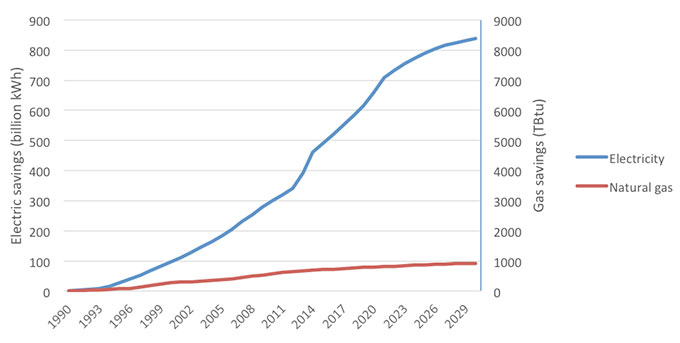With cumulative dollar savings from products sold through 2035 estimated at over one trillion, appliance, equipment, and lighting efficiency standards are making a huge impact nationally. The savings are of such a magnitude that most of us can barely grasp how large they are.
A trillion dollars is a LOT of money.
- With one trillion dollars, you could give every person in the US $3000 and still have some left over.
- If you’d spent one million dollars a day since the year 1, you wouldn’t have reached a trillion dollars yet (you wouldn’t even reach it until sometime in the 2700s).
Appliance standards accomplish trillion-dollar savings by assuring a minimum level of energy and water efficiency for household and commercial appliances, resulting in energy savings for consumers and businesses. Once a national standard goes into effect, for clothes washers for example, it applies to every clothes washer sold or imported into the United States. Standards spread the “energy-saving” wealth around.
The energy savings are equally as impressive. The graph below shows annual electricity and natural gas savings from appliance standards. The 2012 The Efficiency Boom report, published by ACEEE and the Appliance Standards Awareness Project (ASAP), estimated that electricity savings from standards represented 7% of US annual electricity use in 2010. By 2014—just 4 years later—the savings had grown to 12% of annual electricity use. The 2014 savings also amounted to 4% of end-use natural gas consumption. Savings grow as new appliance standards take effect and as older appliances and equipment are replaced with more-efficient ones. Standards for central air conditioners and several types of lighting account for most of the increase.
Savings of national appliance, equipment, and lighting standards by year.
Source: Appliance Standards Awareness Project (unpublished update of an analysis in Lowenberger et al. 2012).
And what about the products themselves? The 2013 ACEEE/ASAP Better Appliances report analyzes how choices available to consumers have changed over time as efficiency standards have taken effect. As products have become more efficient, the report finds that performance has generally stayed the same or improved and new features have been offered to consumers (e.g., through-the-door ice on refrigerators, steam cycles on washers, longer lifetime for lighting). In the majority of cases analyzed, the price of the product either stayed the same or declined. In the few cases where the price was higher, the price increases were outweighed by electricity bill savings.
The power of appliance standards: not only trillion-dollar savings, but less wasted energy, more-efficient appliances and better variety. Not a bad outcome!
For more on national energy metrics, see Energy Efficiency in the United States: 35 Years and Counting.
Data Points is a blog series focusing on the graphs and other images that tell the energy efficiency story.

